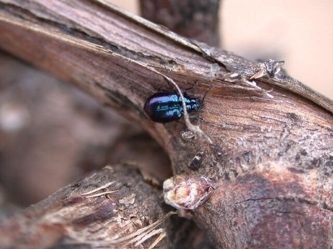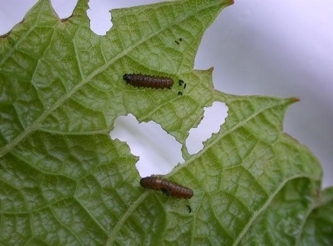Altica spp.
Identification
The Grape flea beetle, Altica spp. (Coleoptera: Chrysomelidae), is a native pest that attacks buds of wild and cultivated grapevines as well as our native Virginia creeper (Parthenocissus quinquefolia). They are approximately 1/10 inch long, shiny blue-purple to blue-green with enlarged hind legs for jumping. Grape flea beetles overwinter as adults under the soil surface or in wood crevices, in and around the grapevines.

Life Cycle
In the early spring, the adults emerge from overwintering sites, feed upon grape buds, mate and lay eggs. The larvae emerge in about two weeks and begin feeding on leaves. Between late June and late July, the larvae will drop to the ground to pupate. Adult beetles emerge in late July and feed on grapevine leaves but they do not mate or lay eggs. In the fall the adults move to overwintering sites. There is one generation per year in Connecticut. Usually infestations are localized. However, in plantings located near favorable hibernating quarters such as wasteland, woodland, and abandoned vineyards, feeding can be severe, especially in the border rows.
Damage
The most serious damage occurs in the spring when adult beetles chew holes in the sides and ends of primary and secondary buds preventing fruit development. Larvae will also feed on the foliage but this is typically does not usually affect grape quality or yield.

Management
Wherever possible it is advisable to tidy wasteland and woodland located near cultivated vineyards or even a few backyard grapevines. This eliminates or reduces hibernating sites. Frequent cultivating or on a larger scale, discing, to control weeds between grape rows can also break the pupal cells in the soil. This exposes the delicate pupa to the elements and it dries up. However, some adults will still emerge from the undisturbed band of soil beneath the trellis which was not touched by the cultivating/discing operation. To prevent bud feeding, treatment with a broad-spectrum insecticide is effective against adults migrating to grapevines from their hibernation sites, but timing is very critical.
At the time larvae and beetles are feeding on the upper surface of grape leaves, they are easily controlled by spraying. The insecticide treatments applied post bloom against the grape berry moth will also help reduce grape flea beetle populations. If grape flea beetles are a pest on your grapevines, contact the UConn Home & Garden Education Center (877) 486-6271 (toll-free in CT) for recommended control materials and application times.
Despite good cultural practices, pests and diseases at times may appear. Chemical control should be used only after all other methods have failed.
For pesticide information or other questions please call toll free: 877-486-6271.
Revised by the UConn Home & Garden Education Center, 2016.